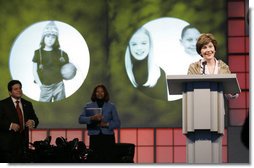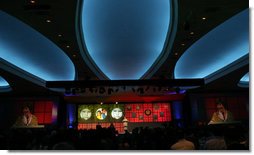
 |
For Immediate Release
Office of the First Lady
January 10, 2006
Mrs. Bush's Remarks at the Office of Juvenile Justice and Delinquency Prevention Conference
The Hilton Washington Hotel
Washington, D.C.
11:05 A.M. EST
The FIRST LADY: Thank you all very much. And, thanks so much to the Attorney General. Thank you, Alberto, for what you do every day. But I'm especially grateful to Al and to Regina Schofield for what they did at the Helping America's Youth summit. Both of them were very actively involved in that summit, and Alberto Gonzales actually spoke at part of it. So I want to thank both of them.
 I want to thank everybody here for everything you do to help
children and teenagers. Whether you work in social service, or
education, or law enforcement, your work is vital to helping young
people stay on the right path so they can set great goals for
themselves, and then so they can develop the confidence to achieve those
goals.
I want to thank everybody here for everything you do to help
children and teenagers. Whether you work in social service, or
education, or law enforcement, your work is vital to helping young
people stay on the right path so they can set great goals for
themselves, and then so they can develop the confidence to achieve those
goals.
The Helping America's Youth initiative is a way to help American young people grow up to be healthy and successful. And I'd like for you to be part of our work.
As the Attorney General mentioned, President Bush announced the Helping America's Youth initiative at his State of the Union address a year ago, and he asked me to lead it. During my husband's first term, I had concentrated mostly on early childhood development and early childhood education. But I've also always been interested in older children and young adults, and in their lives and what we can do to help them establish really healthy and successful lives.
So over the last year, I've traveled to many parts of our country, visiting with young people and with the adults who are so important to their lives. I've been to schools and to after-school programs. I've met with mentors and Big Brothers and Big Sisters. I've visited with gang intervention programs -- one of them, Homeboy Industries in Los Angeles, where I met the young people who are leaving gangs and finding jobs thanks to the inspiration of Father Gregory Boyle, who started Home Boy Industries.
At the White House Conference on Helping America's Youth, which concluded this year of travel, Father Boyle spoke. And he spoke about the power of hope in a young person's life. He said, "I've never met a hopeful kid who joined a gang."
The White House conference featured scholars, researchers, and other adults who work directly with young people. They shared the statistics, the results of many programs that many of them had started, anecdotal evidence, and their own experience. And then we introduced the Community Guide to Helping America's Youth, which I'll talk about in a little bit in my speech.
Many of you in this room are fortunate to have had two parents who showed you love and instilled in you the importance of education, and hard work, and good character. When I was growing up, it was common for most children to have two parents to rely on. And in Midland, Texas, I could count on just about every adult in town knowing who I was and what I was doing. And they'd report it to my mother if they saw me doing something they thought I shouldn't.
 Today, America's children and young people face many more dangers
than we did just a generation ago. Drugs and gangs, predators on the
Internet, violence in real life and on TV and movie screens are just
some of the negative influences today in American children's lives.
Today, America's children and young people face many more dangers
than we did just a generation ago. Drugs and gangs, predators on the
Internet, violence in real life and on TV and movie screens are just
some of the negative influences today in American children's lives.
And as today's children face greater dangers, they often have fewer people to turn to for help. More children are raised in single-parent families, most often without a father. Millions of children have one or both parents in prison. Boys and girls spend more time by themselves or with a group of their peers than with many family members.
Young people need positive influences in their lives, and with the Helping America's Youth initiative, we can make sure that happens. We want every child to be surrounded by caring adults who provide love, advice, and encouragement, and who can serve as good role models. We're taking action in the most important parts of a child's life -- family, school, and community.
Families are the foundation of every child's life. And we must do all we can to help families stay together. Through programs like the Fatherhood initiative or the Marriage initiative, the administration supports ways to help parents stay together and to help men be involved and responsible dads.
Schools are at the heart of Helping America's Youth because every child must have a good education to have a bright future. Today, our schools are improving thanks to accountability, higher standards, and the hard work of teachers and principals who bring out the best in their students. But many students in middle school and high school have been moved through the school systems without mastering vital skills like reading. The Striving Readers program provides funds from the federal government that schools can use to help adolescents improve their reading skills and become proficient at grade level. With stronger reading skills, these students are more likely to graduate high school and more likely to succeed in life.
Communities are the third pillar of Helping America's Youth, and communities support the other two pillars. Strong communities support families, so that parents know the values they teach will be reinforced when their children are outside the home. Strong communities bolster the work of schools by providing educational and safe after-school activities for students. And strong communities nurture healthy children by surrounding them with a network of loving people who keep them safe and can help guide them toward a successful future.
Forming what we call "community coalitions" is an important step in reaching children who need help. Community coalitions bring together everyone in a community, from teachers, to mentors, to pastors, to parents, to police officers, substance abuse experts, social service providers, and business leaders. Anyone who can have a positive impact on a child's life should be part of a community coalition.
You are all leaders in your communities. You have positions of respect, and authority. You have contacts with other people in your community who work with children. You're well-versed in the issues that are faced by the young people in your community. And you have ideas about how to address these tough problems.
We need your help.
I'm asking you personally, when you go back home, to contact people in your community who want to make an extra effort to help America's youth; work together to form a community coalition. And make sure you include children and young people themselves, because their opinions and their experiences can be very informative.
The federal government can help make your community coalition
effective. The Community Guide to Helping America's Youth helps
communities assess their unique local needs and find programs and
resources to meet them. The Guide is available at
www.HelpingAmericasYouth.gov
The Guide is easy to use. With the community inventory feature, community members can answer questions about their town and receive feedback about where problem areas exist. Then the Guide will direct communities to more information about programs and resources that are designed to address the challenges they face. You can put a map of your community on the assessment guild. Your law enforcement can lay out crime statistics on this map. You can plug in your Boys' and Girls' Clubs, your public libraries, all of the things that offer children help. And then you can see which parts of your communities have the highest crime statistics, need the most law enforcement, and need other programs to help children in those communities.
The Helping America's Youth website was developed, tested, and is managed by a team of seven White House Offices and nine federal agencies, including the Office of Juvenile Justice and Delinquency Prevention. The Community Guide includes more than 180 programs that are shown to be effective at preventing and reducing juvenile delinquency and other problem behaviors.
I'm pleased to say that since October 27th when the website was introduced, the site has been used by more than 30,000 people. And 80 communities have registered to use the community inventory feature. These communities now have access to a number of resources that can help them improve life for the children in their communities.
I've visited many communities during the last year, meeting people who are helping children develop a strong character, a love of education, and the self-respect and self-control to stay away from violence, gangs, and drugs. One of the first visits I made was to "Think Detroit," a program that teaches character development and healthy behavior through sports. After my visit, a newspaper reporter asked one of the little boys that I'd met what he thought about my visit. And I was moved when I read that he simply said, "I wish she could stay here."
Children want us in their lives and they need us in their lives. And as I've witnessed all across America, each of us has the power to help America's youth.
Thank you very much for your wonderful work. Have a great conference in Washington, DC, and remember to visit the Helping America's Youth website when you get home. Thank you all very much. (Applause.)
END 11:16 A.M. EST